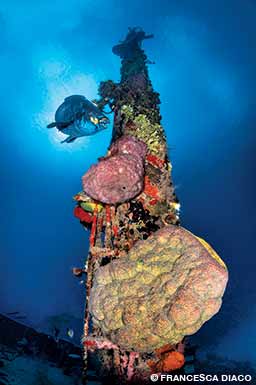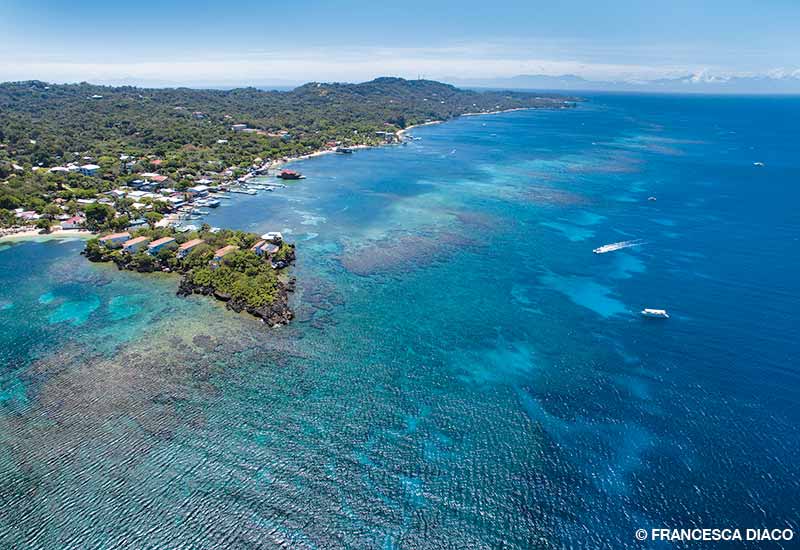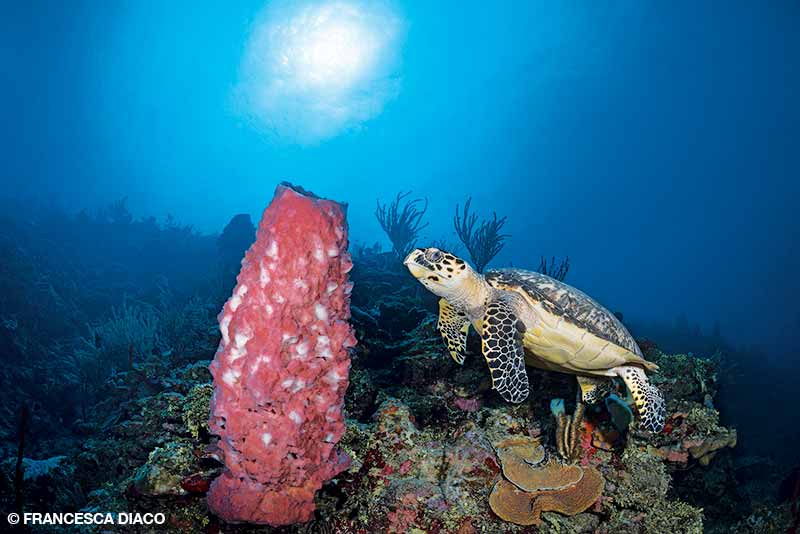Located in the Bay Islands of Honduras, Roatán is a tropical gem nestled in the turquoise waters of the Caribbean Sea. No matter how many times I approach for landing, the view of this lush, mountainous island ringed by coral reefs never ceases to take my breath away.
The largest of the Bay Islands, Roatán sits about 30 miles off the Honduran coast between Utila and Guanaja. Its fringing reef system makes up the southernmost edge of the Mesoamerica Reef (the world’s second-largest reef system) and is arguably Roatán’s biggest attraction. Approximately 30 miles long and 5 miles at its widest point, the island offers a diverse topography above and below the surface. It blends a rustic charm with modern comforts to create a truly authentic experience for travelers.

My history on Roatán dates back to 2000, when I arrived via an unexpected detour. Having just quit my corporate job in New York City, I was backpacking through Central America and ended up in Utila to do some diving. After a few fun-filled days, I got sick, and the doctor insisted I go to Roatán for a proper evaluation. Despite my ardent protests, I was escorted into a three-seat plane with the promise I could return the next day if everything checked out.
Let’s just say I am glad I brought my bags. After getting a quick checkup and IV fluids for dehydration, I felt like a new woman, and the beach village of West End immediately felt like home. Instead of spending one day, I ended up staying for five weeks — a familiar Roatán tale. Then I returned a month later to do my divemaster and instructor training and quickly got a job as an instructor, making Roatán one of the best detours I ever made.
The island was a bit quieter and simpler back then, with fewer dive shops and tourists, more dirt roads and no widespread communications — only one dial-up internet café. If you wanted to see someone, you had to go and find them, which fostered a deep community connection. At the end of each day, everyone would wander down to the local beach bar to watch the sunset and share dive stories over a few cold beers.
We would talk about the amazing visibility, our turtle and eagle ray encounters, macro critters we spotted or a new swim-through we discovered. We would debate the best way to dive the wreck or explore the canyons and share the most recently spotted seahorse locations. On the most exciting days we would brag about swimming with pods of dolphins, encountering whale sharks or spotting the elusive hammerhead. We would end our days staring at the horizon as the sun set, trying to see the elusive green flash. In this regard, nothing has changed. The dive community is still close-knit but extremely inclusive and accessible to divers of all levels.
The topside landscape is different in Roatán now, with newly paved roads, more dive centers and hotels, a wide variety of tourist attractions and businesses, and ubiquitous Wi-Fi. While the island is developing, the vibe and community culture have remained the same — that’s what makes Roatán so special and why I call it home.

It’s not uncommon for a first-time visitor to become a repeater, an extended-stay guest or even a new homeowner. Roatán has a certain charm and a particular way of making you feel at home. Many of us locals affectionately refer to this as “the vortex” — you may leave, but eventually the island draws you back. I spent three years there before setting off to explore what the rest of the world had to offer. My work and travels took me to some of the most popular dive destinations in the world: Indonesia, Australia, Palau, Fiji, Papua New Guinea and others. I spent a decade exploring the rich, biodiverse Indo-Pacific waters before Roatán pulled me back home. When I returned, the island community welcomed me back as if not a day had passed. The vortex is real.
Roatán offers something for just about any type of traveler: from deserted, coconut-palm-lined beaches to bustling tourist villages, lush jungles and busy waterfronts that provide all the food, beverages and activities travelers often crave. While more touristic markets and attractions have popped up, the island has avoided the cultural sterilization that often happens in more developed Caribbean destinations. It’s casual (flip-flops are all you need) and easy to navigate, and it offers excellent value in diving and accommodation, which is another great equalizer that brings together people. It’s a great place for solo travelers because it won’t take long to make fast friendships — some that might last a lifetime.
For nondiving companions or nondiving days, there are endless adventures and activities to choose from, such as zip lining, deep-sea fishing, island tours by land or boat, handline fishing, wildlife experiences, birding, jungle hikes, botanical gardens, a microbrewery, rum tasting and kite surfing. There is something for every taste, budget and lifestyle, and new and creative offerings pop up all the time.

Roatán Diving
As much as there is to do topside, it is the reef that put Roatán on the tourist map. It’s arguably some of the best and most affordable diving in the Caribbean. The fringing reef is positioned at the edge of the Cayman Trench and offers diverse underwater topography and dive sites just moments from shore. With steep walls, sloping reefs, shallow coral gardens, sandy patches, mangroves, swim-throughs, canyons, caves and several exciting wrecks, Roatán has something for every diver.
Roatán also offers convenient and low-maintenance diving. The waters are clear, blue, calm and typically not subject to strong currents. The short, easy boat rides provide a lot of scheduling flexibility to dive the plan you like. Casual divers can hop out for a quick, one-tank dive and then spend the day drinking cocktails on the beach. Die-hards can fit in as many as three or four dives a day with plenty of time in between for baleadas — a fresh tortilla filled with beans, egg, avocado and whatever you like — a Roatán specialty.

This easy vibe makes Roatán the perfect place to get your gills wet for the first time, get certified, learn specialties, go pro with divemaster or instructor training, learn and practice underwater photography, test new dive or photo gear, take a freediving course or explore technical diving. There is a dive culture here for everyone. You can even experience Roatán’s reefs up to 2,000 feet deep in a submarine. The ideal conditions make the island a great place for friends and family of varying experience levels to dive together without affecting anyone’s enjoyment.
With many dive sites all around the island and more being discovered, you can find somewhere new to explore or a different way to dive an old favorite. Roatán dive professionals are passionate and creative and are always coming up with fresh dive experiences. Talk to locals about your favorite type of diving, and they will likely come up with an imaginative, funky plan that suits your style. While Roatán is not known for muck diving, for example, there are knowledgeable, eagle-eyed dive professionals who would be keen to take you critter hunting in 5 feet of water for an hour or two. Be sure to bring your magnifiers for these tiny creatures, some extra weight and your best buoyancy control so you don’t stir up the bottom.
Easy conditions and short boat rides make it an ideal place for night diving. Not only can you see many different species at night such as more nudibranchs and maybe a hunting octopus, but you can also often see the bioluminescent “string of pearls.” If the moon phase and conditions are right, your guide will ask you to turn off your lights and watch the reef come to life. The magical sight that looks like thousands of strands of fairy lights hanging vertically in the water is the mating display of ostracods.
For the more advanced and adventurous divers, Roatán also has a blackwater dive experience upon request. This dive centers around lights placed in the water column to attract the weird and wonderful critters and larval species from the deep. The otherworldly experience makes you feel like you are hunting aliens in space.

As for marine life, Roatán has all the usual suspects you expect to see in Caribbean waters, including sea turtles, eagle rays and stingrays, moray eels, a plethora of schooling and large fish, and various shrimp, blennies, gobies and crabs as well as flamingo tongues, lettuce sea slugs and other cowries. Slightly less common marine life includes nurse sharks, frogfish, seahorses, pipefish, pipehorses, a variety of nudibranchs, tarpon, dolphins, hammerheads, whale sharks and the occasional manta. The island also sometimes gets some pelagic migrations that offer exciting and elusive blue-water encounters with orcas, sperm whales and pilot whales, among others.
Certain times of year provide opportunities to see some special things. You might find swarms of silversides in particular caves and swim-throughs in June, July or possibly other times of the year, and May is a great time to spot juvenile trunkfish. My insider tip is to get friendly with our local conservation experts and offer to volunteer your time. It might lead to some exciting dive opportunities.
One of my favorite Roatán dive experiences is the seamounts, about a 45-minute boat ride offshore. This trip is a half-day, two-tank dive excursion that requires favorable weather conditions and calm seas due to its exposed nature. These seamounts are for experienced divers because they sit a bit deeper (starting at about 40 to 70 feet, depending on the dive site) and are subject to strong currents. If you can make the dive, you’ll see plenty of action. Not only is the coral beautiful here, but you also get many large schools of fish, including barracudas, jacks and spadefish. A curious resident nurse shark is usually happy to buzz in close for a photo opportunity. The trips to and from the seamounts and the surface interval provide fantastic opportunities to see bigger things such as dolphins, pelagic sharks and, if you’re extremely lucky, whale sharks.
Cordelia Banks and Conservation
One of Roatán’s most rare and precious underwater resources is Cordelia Banks, home to a truly unique coral phenomenon. This protected area encompasses four coral banks, including Smith Bank, which is home to approximately 52 acres of staghorn coral. This species has had a population loss of more than 90 percent throughout the Caribbean since the 1980s.
Located in the southwest part of the island between two of its most populated areas, Cordelia is a natural wonder and one of the few remaining known sites in the Caribbean with a large staghorn population. There are hypotheses on why these vast coral fields survived the mass extinction of this species, but there is still so much that we don’t know. Researchers are working hard to determine whether specific patches can be used as genetic banks or breeding grounds for surrounding areas, which are essential for reef growth and important in providing fish habitats. Given its level of importance, the vast majority of Cordelia is protected and not open to divers, but you can explore some stunning fringe areas.

Coral Restoration
Several coral restoration efforts are using fragments from Cordelia Banks to populate coral nurseries around the island. These nurseries consist of what look like giant Christmas trees decorated with coral ornaments. Made from PVC pipe and fiberglass rods, the trees are attached to the seafloor with moorings. Divers collect healthy coral samples, which are then fragmented and hung from the trees with monofilament and metal crimps to grow until they are large enough to put back on the reef.
Roatán’s nurseries are stocked with two endangered coral species, elkhorn and staghorn, which are two of the most critical once-abundant species in the Caribbean. Each tree holds a single genotype to preserve genetic diversity and is cleaned regularly until it is time to replant the corals.
Staghorn corals are ready for outplanting when they grow to about 1 foot long and have many branches and no diseased spots, which takes approximately six to nine months. Elkorn corals need to be about 4 inches, which can take nine to 12 months. When the corals are ready to leave the nursery, they are planted on the reef in clusters to fuse as they grow, and a portion is tagged to assist in research and monitoring.
Any diver visiting Roatán can participate in coral restoration. Select dive centers offer the opportunity to learn about the project and the option of diving a nursery to help clean the coral trees or participating in a survey dive to monitor the condition of recently replanted coral.

Roatán Marine Park
Conservation is a huge part of Roatán’s culture, thanks in large part to the close-knit dive community and most notably the Roatán Marine Park (RMP). This community-based nonprofit organization works tirelessly in education, training, conservation and research. The RMP relies heavily on donations to fund essential patrols that protect the reef and to install and maintain mooring buoys. It also engages in educational endeavors, community-outreach programs and efforts to treat and slow stony coral tissue loss disease.
Visitors can help by making a simple donation, visiting the RMP store, taking a workshop to learn how to help control the lionfish population, volunteering or buying a mooring buoy (that you get to name).
For more information, visit roatanmarinepark.org.
How To Dive It
Sampai di sana: Juan Manuel Gálvez International Airport (RTB) on Roatán has direct flights year-round from Atlanta, Dallas, Houston, Miami, Minneapolis, Montreal and Toronto. Carriers operate these flights only on certain days of the week according to the season. Additional flights are available from mainland Honduras out of Copan, La Ceiba, San Pedro Sula and Tegucigalpa. Public ferries and private charters are other options.
Kondisi: Roatán is excellent year-round, but be aware of changing weather and seasons. The high season runs from mid-December through April. November through April are the coolest months. Late October through February is the winter rainy season, so stronger winds and more rain are possible. Roatán’s fringing reef provides diving on all sides of the island, so there is always somewhere to dive whatever the weather. The water is warm year-round, usually in the mid-80s°F, with excellent visibility ranging from 66 to 100 feet.
Entry requirements: Visitors from the U.S. can find international travel information, passport requirements, current advisories and COVID-19 testing requirements at travel.state.gov.
Jelajahi Lebih Lanjut
See more of remarkable Roatán in a galeri foto bonus and this video.